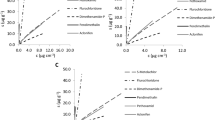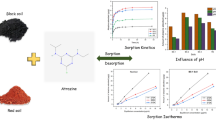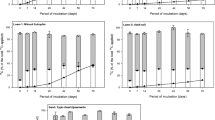Abstract
Thiencarbazone-methyl, a triazole herbicide was assessed for its environmental fate by carefully imitating and analyzing the natural pedosphere through diverse experiments involving adsorption, desorption, hydrolysis, photo-degradation and degradation in ten distinct soils. Sorption experiments were performed through batch equilibrium method. Soils’ physicochemical properties highly influenced the sorption of the herbicide. Results were characteristic of an overall weaker physisorption and an exothermic response reflected by means of negative qualities for Gibbs free energy. Hydrolytic, photolytic and soil degradation experiments were performed for thiencarbazone-methyl for determination of the impact of biotic and abiotic parameters on its degradation. UV–Vis spectrophotometer and GC–MS was utilized for the investigation of thiencarbazone-methyl-treated soils after extraction at regular intervals. The adsorption co-efficient value ranged from 4.3 to 26.4 µgml−1. Minimum half-life in hydrolysis, photo-degradation and soil degradation experiments was 18, 18.7 and 16 days, respectively; while, the highest was 22, 22.6 and 23.9 days, respectively. Results depict moderate binding and low persistence of thiencarbazone-methyl to the selected soils whilst being highly susceptible to transformative pathways.










Similar content being viewed by others
References
Abdelbagi AO, Wady AIA, Ishag AESA, Hammad AMA, Abdalla MAO, Hur JH (2018) Biodegradation of fenthion and temphos in liquid media by Bacillus safensis isolated from pesticides polluted soil in the Sudan. Afr J Biotechnol 17:396–404
Abdelwaheb M, Jebali K, Dhaouadi H, Dridi-Dhaouadi S (2019) Adsorption of nitrate, phosphate, nickel and lead on soils: Risk of groundwater contamination. Ecotoxicol Environ Safety 179:182–187
Ahmad I, Khattak AM, Ara N, Amin NU (2011) Effect of planting dates on the growth of gladiolus corms in Peshawar. Sarhad J Agric 27:195–199
Ahmad KS (2017) Investigating the impact of soils’ physiochemical composition on chlorsulfuron pedospheric sorption. Stud Univ Babes Bolyai Chemia 62:165–174
Ahmad KS (2018a) Evaluating the adsorption potential of Alachlor and its subsequent removal from soils via activated carbon. Soil Sed Contam Int J. https://doi.org/10.1080/15320383.2018.1470604
Ahmad KS (2018b) Sorption and Juglans regia-derived activated carbon-mediated removal of aniline-based herbicide Alachlor from contaminated soils. Environ Earth Sci 77:437
Ahmad KS (2020) Environmental contaminant 2-chloro-N-(2, 6-diethylphenyl)-N-(methoxymethyl) acetamide remediation via Xanthomonas axonopodis and Aspergillus niger. Environ Res 182:109117
Ahmad KS, Gul P (2020) Fungicide isopyrazam degradative response toward extrinsically added fungal and bacterial strains. J Basic Microbiol 60:484
Ahmad KS, Rashid N (2015) Sorption-desorption behavior of newly synthesized N-(1H-Benzimidazole-2 ylmethyl) Acetamide (ABNZ) on Selected Soils and its Antifungal activity. J Chem Soc Pak 37:841–849
Amorim CC, Bottrel SEC, Costa EP, Teixeira APC, Leao MMD (2013) Removal of ethylenthiourea and 1,2,4-triazole pesticide metabolites from water by adsorption in commercial activated carbons. J Environ Sci Health B 48:183–190
Bloom DE (2011) 7 billion and counting. Science 333:562–569
Chau AS (2018) Analysis of pesticides in water: volume I: significance, principles, techniques, and chemistry of pesticides. CRC Press, Baco Raton
Dal BoscoSampaio TCSC, Coelho SR, Cosmann NJ, Smanhotto A (2012) Effects of the organic matter from swine wastewater on the adsorption and desorption of Alachlor in soil. J Environ Sci Health B 47:485–494
Damalas CA, Khan M (2017) Pesticide use in vegetable crops in Pakistan: Insight through an ordered probit model. Crop Prot 99:59–64
European Food Safety Authority (2013) Conclusion on the peer review of the pesticide risk assessment of the active substance thiencarbazone-methyl. EFSA J 11:3270
Giannakopoulos G, Dittgen J, Schulte W, Zoellner P, Helmke H, Lagojda A, Edwards R (2020) Safening activity and metabolism of the safener cyprosulfamide in maize and wheat. Pest Manag Sci 76:3413
Godsey CB (2007) Change in soil pH, organic carbon, and extractable aluminum from crop rotation and tillage. Soil Sci Soc Am J 71:1038–1044
Grey TL, Walker RH, Wehtje GR, Hancock HG (1997) Sulfentrazone adsorption and mobility as affected by soil and pH. Weed Sci 45:733–738
Gul MM, Ahmad KS (2018) Chlorsulfuron degradation through bio-augmentation of soils by fungal strains and chemical hydrolysis. J Environ Chem Eng 6:955–963
Gul MM, Ahmad KS (2020) Assessment of methyl 2-({[(4, 6-dimethoxypyrimidin-2-yl) carbamoyl] sulfamoyl} methyl) benzoate through biotic and abiotic degradation modes. Open Chem 18:314–324
Han W, Zhong C, Liang L, Sun Y, Guan Y, Wang L, Sun X, Li J (2014) Electrochemical degradation of triazole fungicides in aqueous solution using TiO2-NTs/SnO2-Sb/PbO2 anode: experimental and DFT studies. Electrochim Acta 130:179–186
Haque MA, Hong SY, Hwang CE, Kim SC, Cho KM (2018) Cloning of an organophosphorus hydrolase (opdD) gene of Lactobacillus sakei WCP904 isolated from chlorpyrifos-impregnated kimchi and hydrolysis activities of its gene product for organophosphorus pesticides. Appl Biol Chem 61:643–651
Herrera H, Palma G, Almonacid L, Campos R, Fuentes A, Garcia-Romera I, Arriagada C (2019) Improving soil simazine dissipation through an organic amendment inoculated with trametes versicolor. J Soil Sci Plant Nutri. https://doi.org/10.1007/s42729-019-0019-7
Hu P, Guo C, Zhang Y, Lv J, Zhang Y, Xu J (2019) Occurrence, distribution and risk assessment of abused drugs and their metabolites in a typical urban river in north China. Front Environ Sci Eng 13:56
Iftikhar S, Ahmad KS, Gul MM (2018) Low-cost and environmental-friendly Triticum aestivum-derived biochar for improving plant growth and soil fertility. Comm Soil Sci Plant Anal 49:2814–2827
Ishaq S, Begum F, Ali K, Ahmed S, Ali S, Ali H, Sher Sultan Baig M, Khan Z, Ali S (2015) Soil quality assessment using selected physico-chemical indicators in Altit Hunza, Gilgit-Baltistan. J Biodiv Environ Sci 6:454–459
Janaki P, Chinnusamy C, Sakthivel N, Nithya C (2015) Field dissipation of pendimethalin and alachlor in sandy clay loam soil and its terminal residues in sunflower (Helianthus annus L.). J Appl Nat Sci 7:709–713
Kandpal N, Dewangan HK, Nagwanshi R, Ghosh KK, Satnami ML (2017) An investigation of kinetic and physicochemical properties of vesicular surfactants with oximate and hydroxamate ions: hydrolytic reactions of organophosphorus pesticides. J Mol Liq 243:178–186
Khan S, Rehman S, Khan AZ, Khan MA, Shah MT (2010) Soil and vegetables enrichment with heavy metals from geological sources in Gilgit, northern Pakistan. Ecotoxicol Environ Safety 73:1820–1827
Kodešová R, Kočárek M, Kodeš V, Drábek O, Kozák J, Hejtmánková K (2011) Pesticide adsorption in relation to soil properties and soil type distribution in regional scale. J Hazard Mater 186:540–550
Koskinen WC, Calderón MJ, Rice PJ, Cornejo J (2006) Sorption–desorption of flucarbazone and propoxycarbazone and their benzenesulfonamide and triazolinone metabolites in two soils. Pest Manag Sci 62:598–602
Kubier A, Wilkin RT, Pichler T (2019) Cadmium in soils and groundwater: a review. Appl Geochem 108:1–16
Kumar M, Philip L (2006) Adsorption and desorption characteristics of hydrophobic pesticide endosulfan in four Indian soils. Chemosphere 62:1064–1077
Kumar N, Mukherjee I, Sarkar B, Paul RK (2017) Degradation of tricyclazole: effect of moisture, soil type, elevated carbon dioxide and Blue Green Algae (BGA). J Hazard Mater 321:517–527
Lei W, Zhou X (2017) Experiment and simulation on adsorption of 3, 5, 6-Trichloro-2-Pyridinol in typical farmland of purple soil, Southwestern China. Soil Sed Contam Int J 26:345–363
Li X, Grey T, Price K, Vencill W, Webster T (2018) Adsorption, desorption and persistence of fomesafen in soil. Pest Manag Sci 75:270–278
Liu Y, Xu Z, Wu X, Gui W, Zhu G (2010) Adsorption and desorption behavior of herbicide diuron on various Chinese cultivated soils. J Hazard Mater 178:462–468
Lutz W, Samir KC (2010) Dimensions of global population projections: what do we know about future population trends and structures? Phil Trans Royal Soc B Biol Sci 365:2779–2791
Maddila S, Pagadala R, Jonnalagadda SB (2013) 1,2,4-triazoles: a review of synthetic approaches and the biological activity. Lett Org Chem 10:693–714
Masbou J, Drouin G, Payraudeau S, Imfeld G (2018) Carbon and nitrogen stable isotope fractionation during abiotic hydrolysis of pesticides. Chemosphere 213:368–376
Michalkova A, Gorb L, Hill F, Leszczynski J (2011) Can the Gibbs free energy of adsorption be predicted efficiently and accurately: an M05–2X DFT study. J Phys Chem A 115:2423–2430
Moorman TB (2018) Pesticide degradation by soil microorganisms: environmental, ecological, and management effects. In: Hatfield JL (ed) Soil biology. CRC Press, Boca Raton, pp 127–172
Naeem H, Ahmad KS, Gul MM (2020) Agrochemical 2-chloro-2', 6'-diethyl-N-methoxymethylacetanilide tranformative and sorptive demeanor in agriculturally significant pedospheric environs. Int J Environ Anal Chem. https://doi.org/10.1080/03067319.2019.1700965
Obanda DN, Shupe TF, Catallo WJ (2008) Resistance of trichoderma harzianum to the biocide tebuconazol-proposed biodegradation pathways. Holzforschung 62:613–619
Ohmes GA, Mueller TC (2007) Sulfentrazone adsorption and mobility in surface soil of the southern United States. Weed Technol 21:796–800
Padovani L, Capri E, Padovani C, Puglisi E, Trevisan M (2006) Monitoring tricyclazole residues in rice paddy watersheds. Chemosphere 62:303–314
Popp J, Pető K, Nagy J (2013) Pesticide productivity and food security. A review. Agron Sus Dev 33:243–255
Reedich LM, Millican MD, Koch PL (2017) Temperature impacts on Soil microbial communities and potential implications for the biodegradation of turfgrass pesticides. J Environ Qual 46:490–497
Rodríguez-Cruz MS, Sánchez-Martín MJ, Andrades MS, Sánchez-Camazano M (2009) Modification of clay barriers with a cationic surfactant to improve the retention of pesticides in soils. J Hazard Mater B139:363–372
Sadegh-Zadeh F, Wahid SA, Jalili B (2017) Sorption, degradation and leaching of pesticides in soils amended with organic matter: a review. Adv Environ Technol 2(119–132):7
Scheunert I (2018) Transport and transformation of pesticides in soil. fate and prediction of environmental chemicals in soils, plants, and aquatic systems. CRC Press, Boca Raton, pp 1–22
Sheppard S, Sohlenius G, Omberg LG, Borgiel M, Grolander S, Norden S (2011) Solid/liquid partition coefficients (K d) and plant/soil concentration ratios (CR) for selected soils, tills and sediments at Forsmark (No. SKB-R--11-24). Swedish Nuclear Fuel and Waste Management Co, Stockholm
Shivaramaiah HM (2014) Adsorption, desorption and movement of endosulfan in agricultural soil. Int J Food Agric Vet Sci 4:53–61
Siddique A, Mumtaz M, Zaigham NA, Mallick KA, Saied S, Zahir E, Khwaja HA (2009) Heavy metal toxicity levels in the coastal sediments of the Arabian Sea along the urban Karachi (Pakistan) region. Mar Pollut Bull 58:1406–1414
Song S, Zhang C, Chen Z, Wei J, Tan H, Li X (2019) Hydrolysis and photolysis of bentazone in aqueous abiotic solutions and identification of its degradation products using quadrupole time-of-flight mass spectrometry. Environ Sci Pollut Res 1–9.
Takeshita V, Mendes KF, Pimpinato RF, Tornisielo VL (2020) Adsorption Isotherms of Diuron and Hexazinone in Drinking Water Using Four Agro-Industrial Residues. Planta Daninha 38.
Tebes-Stevens C, Patel JM, Jones WJ, Weber EJ (2017) Prediction of hydrolysis products of organic chemicals under environmental pH conditions. Environ Sci Technol 51:5008–5016
Tian BB, Zhou JH, Xie F, Guo QN, Zhang AP, Wang XQ, Yu QQ, Li N, Yang H (2019) Impact of surfactant and dissolved organic matter on uptake of atrazine in maize and its mobility in soil. J Soils Sed 19:599–608
Van Eerd L, Hoagland R, Zablotowicz R, Hall C (2003) Pesticide metabolism in plants and microorganisms. Weed Sci 51:472–495
Veness J, Patzer KTA, Steckler MK (2008). Thiencarbazone-methyl, a new herbicide active ingredient in Canada. In: Canadian Weed Science Society 62nd Annual Meeting.
Wang C, He X, Wang X, Wang Z, Pan H, He Z (2016) Testing method of spatial pesticide spraying deposition quality balance for unmanned aerial vehicle. Trans Chin Soc Agric Eng 32:54–61
Watanabe N, Horikoshi S, Kawasaki A, Hidaka H, Serpone N (2005) Formation of refractory ring-expanded triazine intermediates during the photocatalyzed mineralization of the endocrine disruptor amitrole and related triazole derivatives at UV-irradiated TiO2/ H2O interfaces. Environ Sci Technol 39:2320–2326
Wu H, Shen J, Wu R, Sun X, Li J, Han W, Wang L (2016) Biodegradation mechanism of 1H–1, 2, 4-triazole by a newly isolated strain Shinella sp. NJUST26. Sci Rep 6:29675
Yang X, Chen X, Yang X (2019) Effect of organic matter on phosphorus adsorption and desorption in a black soil from Northeast China. Soil Till Res 187:85–91
Yavari S, Sapari NB, Malakahmad A, Razali MAB, Gervais TS, Yavari S (2020) Adsorption-desorption behavior of polar imidazolinone herbicides in tropical paddy fields soils. Bull Environ Contam Toxicol 104:121–127
Yavari S, Sapari NB, Malakahmad A, Yavari S (2019) Degradation of imazapic and imazapyr herbicides in the presence of optimized oil palm empty fruit bunch and rice husk biochars in soil. J Hazard Mater 366:636–642
Zhou W, Zhang Y, Li W, Jia H, Huang H, Li B (2019) Adsorption isotherms, degradation kinetics, and leaching behaviors of cyanogen and hydrogen cyanide in eight texturally different agricultural soils from China. Ecotoxicol Environ Safety 185:109704
Acknowledgments
Current research did not receive any funding. The authors acknowledge Higher Education Commission of Pakistan, the Department of Environmental Science (Lab E-21) and Fatima Jinnah Women University, Pakistan.
Author information
Authors and Affiliations
Corresponding author
Ethics declarations
Conflict of interest
Authors declare no conflict of interest.
Additional information
Publisher's Note
Springer Nature remains neutral with regard to jurisdictional claims in published maps and institutional affiliations.
Rights and permissions
About this article
Cite this article
Gul, P., Ahmad, K.S. & Gul, M.M. Herbicide thiencarbazone-methyl pedospheric disposition through sorption and degradation mechanisms in heterogenous soils. Environ Earth Sci 79, 478 (2020). https://doi.org/10.1007/s12665-020-09179-w
Received:
Accepted:
Published:
DOI: https://doi.org/10.1007/s12665-020-09179-w




